Northern Ireland is the smallest of the four political divisions that make up the United Kingdom of Great Britain and Northern Ireland. England, Scotland, and Wales are the other divisions of the United Kingdom, which is often called the U.K. or Britain. Belfast is Northern Ireland’s capital and largest city.
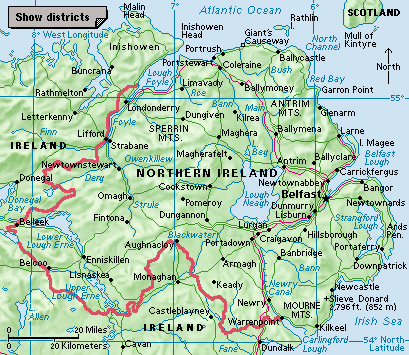
Northern Ireland occupies the northeastern corner of the island of Ireland. It takes up about a sixth of the island. The independent Republic of Ireland occupies the rest of the island. Northern Ireland is often called Ulster. Ulster was the name of one of the four provinces of Ireland until 1920, when Northern Ireland was separated from the rest of Ireland. The old province of Ulster consisted of nine counties. In 1922, six of these counties chose to remain part of the United Kingdom when the Irish Free State was formed. The six counties together became the province of Northern Ireland. See Ulster.
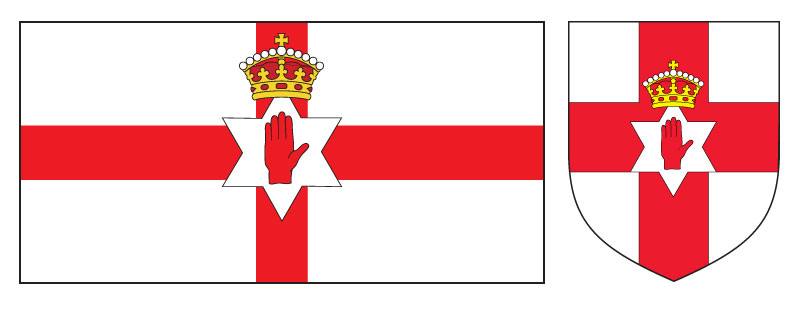
The people of Northern Ireland have long been divided into rival political, social, and cultural groups. About half of the people are unionists, mainly Protestants, who have traditional ties to the rest of the United Kingdom and want Northern Ireland to remain in it. Nearly all the rest of the inhabitants are nationalists, or Republicans, who support the reunification of Ireland. Nationalists are generally Roman Catholics, as are most of the people in the Republic of Ireland to the south. The conflict between unionists and nationalists erupted in the late 1960’s and led to riots, bombings, and other outbreaks of violence and terrorism, often called the Troubles.
Peace agreements in 1998 promised an end to the Troubles, but they proved difficult to carry out. Members of all major political parties, including those allied with paramilitary organizations (military organizations not sponsored by the government), agreed to the establishment of a power-sharing legislature called the Northern Ireland Assembly in December 1999. The Assembly’s Parliament Buildings stand in the Stormont Estate section of Belfast, and Stormont became a commonly used nickname for the lawmaking body. Political conflicts have sometimes led to lengthy suspensions of the Assembly, including from 2002 to 2007, from 2017 to 2020, and from 2022 to 2024.
This article tells about Northern Ireland’s people, geography, and economy and its history beginning with the Protestant settlement of Ireland in the 1600’s. For information on the earlier history of the island of Ireland, see Ireland, History of. For details of the government of Northern Ireland, see Northern Ireland, Government of. For a discussion of the United Kingdom as a whole and of Northern Ireland’s relation to the other political divisions, see United Kingdom. For information on the Republic of Ireland, see Ireland.
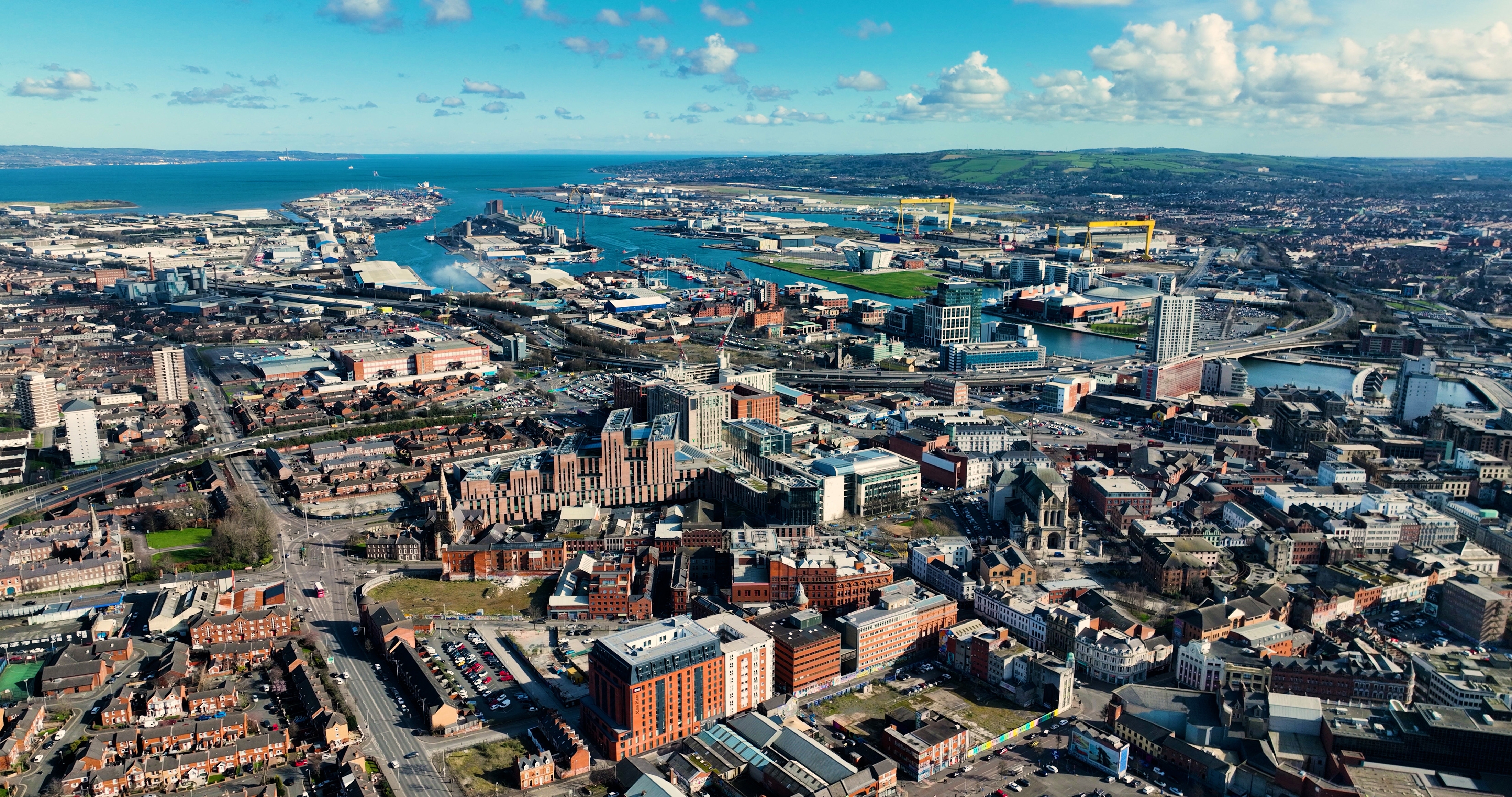
People
Ancestry.
A majority of the people who live in Northern Ireland are descended from English and Scottish settlers who have arrived in Ireland since the 1600’s. Most of the rest trace their ancestry to the earlier Celtic, Viking, and Norman settlers of the island of Ireland.
Language.
English is the official language of Northern Ireland, and all the people there speak it. The Irish language, a form of Gaelic used in the Republic of Ireland, is taught to children in Roman Catholic schools and in some Protestant schools. There is also a growing interest in the Ulster-Scots language, which is found in some of the Ulster counties. See Gaelic languages; Irish language.
Way of life
Most people in Northern Ireland have a way of life similar to that of people in the rest of the United Kingdom. Motion pictures and television programs are popular forms of entertainment. As in the rest of the United Kingdom, pubs (public houses) are an important part of the social lives of many people in Northern Ireland. People gather in pubs to drink beer and other beverages, eat food, talk with friends, and listen to music. See Public houses.
City life and rural life.
About 60 percent of the people of Northern Ireland live in urban areas. Many live in or near the cities of Belfast and Londonderry, which is also called Derry. Rioting and numerous acts of terrorism have disrupted life in Belfast and Londonderry since the 1960’s. However, British government aid and substantial private investment have helped make the cities modern—and more peaceful—urban centers. In Belfast, for example, new hotels, offices, and shopping areas have been built. Large-scale home-building projects have eased the worst housing problems. See Belfast; Londonderry. 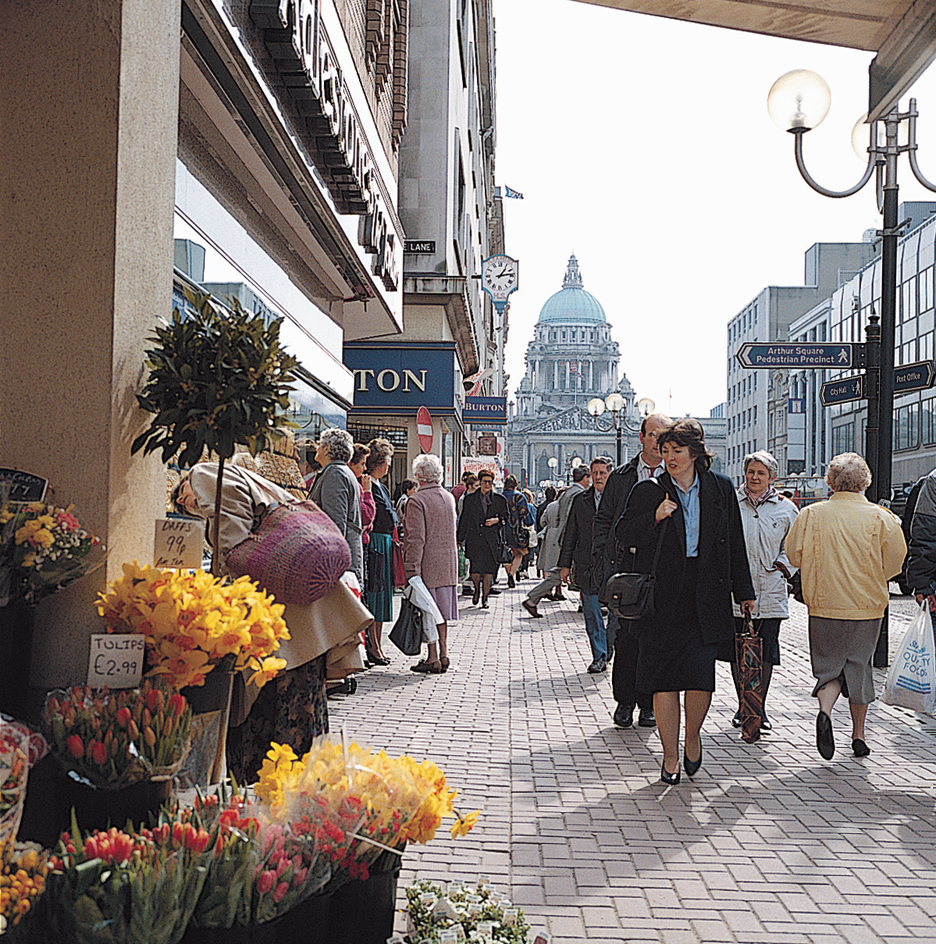
About 40 percent of the people of Northern Ireland live in rural areas. Few of them earn their living by farming, however.
Food and drink.
The people of Northern Ireland have a similar diet to the rest of the United Kingdom and Ireland. It is based on meat, potatoes and vegetables, and bread, but the introduction of other European and Asian cuisines has made the diet more varied. The people of Northern Ireland also eat large amounts of poultry, eggs, dairy products, and fish. Tea is the most popular drink in Northern Ireland. A favorite alcoholic beverage is beer.
Recreation.
Northern Ireland’s most popular organized sport is football, the game that Americans call soccer. Other popular sports in Northern Ireland include cricket, which is played with bats and a ball; Gaelic football, which resembles soccer; handball; hurling and camogie, which are somewhat similar to field hockey; and rugby, a game played with an oval ball. Many people in Northern Ireland also enjoy boating, fishing, golf, and swimming.
Education.
All children in Northern Ireland from age 4 to 16 are required to attend school. Nearly all of them go to schools supported by public funds. Children attend a primary school from age 4 to 11. Some then attend a secondary school, which provides general and vocational education, or a grammar school, which prepares students for higher education. Others attend a comprehensive school, which provides both secondary and grammar school courses. Protestant and Catholic communities are not well integrated, and Roman Catholics operate their own schools. For these reasons, education in Northern Ireland is largely segregated along religious lines. However, Catholic and Protestant parents who are concerned about the continued segregation have established some integrated schools.
There are two universities in Northern Ireland. They are Queen’s University Belfast and the University of Ulster, which has campuses in Belfast, Coleraine, Jordanstown, and Londonderry. See Queen’s University Belfast; Ulster, University of.
Religion.
The majority of Northern Ireland’s people are Protestants or Roman Catholics. The Church of Ireland and the Presbyterian Church are the largest Protestant churches. The Church of Ireland belongs to the Anglican Communion, which also includes the Church of England and the Episcopal Church in the United States. See Church of Ireland.
Some Protestant men belong to an organization called the Orange Order and are known as Orangemen. This organization seeks to keep Protestants in power in the country and to maintain Northern Ireland’s union with the United Kingdom (see Orange Order). The Orangemen hold parades every July 12. The parades celebrate the victory of King William III, a Protestant, over King James II, a Roman Catholic, in the Battle of the Boyne in 1690. The “Twelfth” is a public holiday in Northern Ireland. A similar association of Roman Catholics, the Ancient Order of Hibernians, holds parades on August 15 and sometimes on March 17. 
The arts.
The most famous cultural event in Northern Ireland is the international arts festival hosted each November by The Queen’s University Belfast. This festival features musical performances, dramatic productions, art exhibits, motion pictures, lectures, and other events.
The Ulster Orchestra, based in Belfast, is the most famous musical organization. In addition, several musicians from Northern Ireland established international reputations. They include the flutist James Galway, the pianist Barry Douglas, and the singer Van Morrison.
Northern Ireland is also known for talented writers. Poet Seamus Heaney won the 1995 Nobel Prize in literature. Other widely known writers include poet John Hewitt, novelist Brian Moore, and playwright Brian Friel.
The land
Northern Ireland occupies the northeast corner of the island of Ireland. On the south and west, it is bordered by the Republic of Ireland, which occupies the rest of the island. The North Channel separates Northern Ireland from Scotland to the northeast. The closest point in Scotland lies only 13 miles (21 kilometers) from Northern Ireland. The Irish Sea separates Northern Ireland from England to the southeast. For more information about the geography and climate of Northern Ireland, see United Kingdom (Northern Ireland) (Climate).
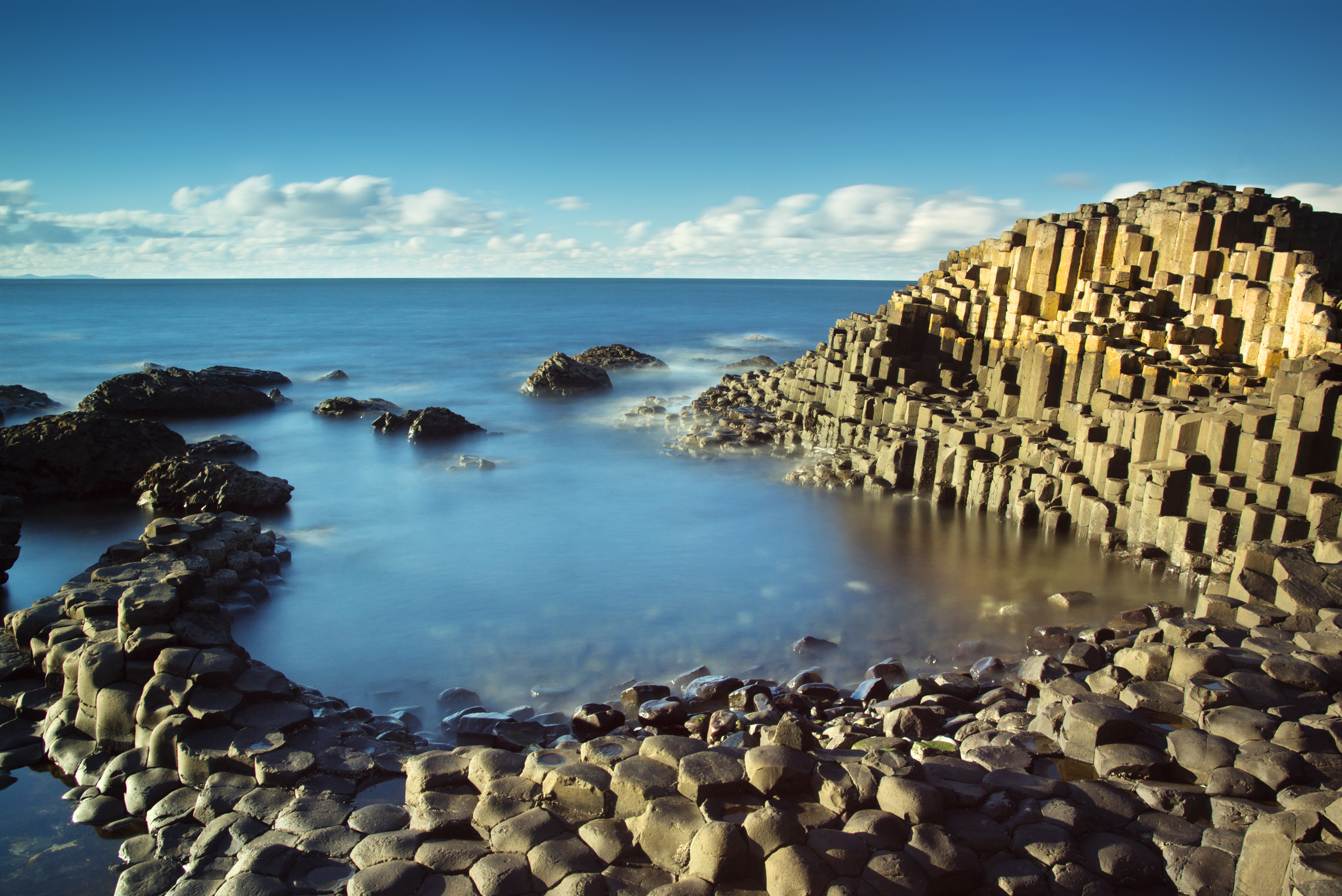
Surface features.
Northern Ireland is a land of rolling plains and low mountains. The plains, which cover the central part of the country, include fertile fields and pasturelands. The mountains, which are near the coast, have many deep, scenic valleys. In some areas, the plains reach to the coast.
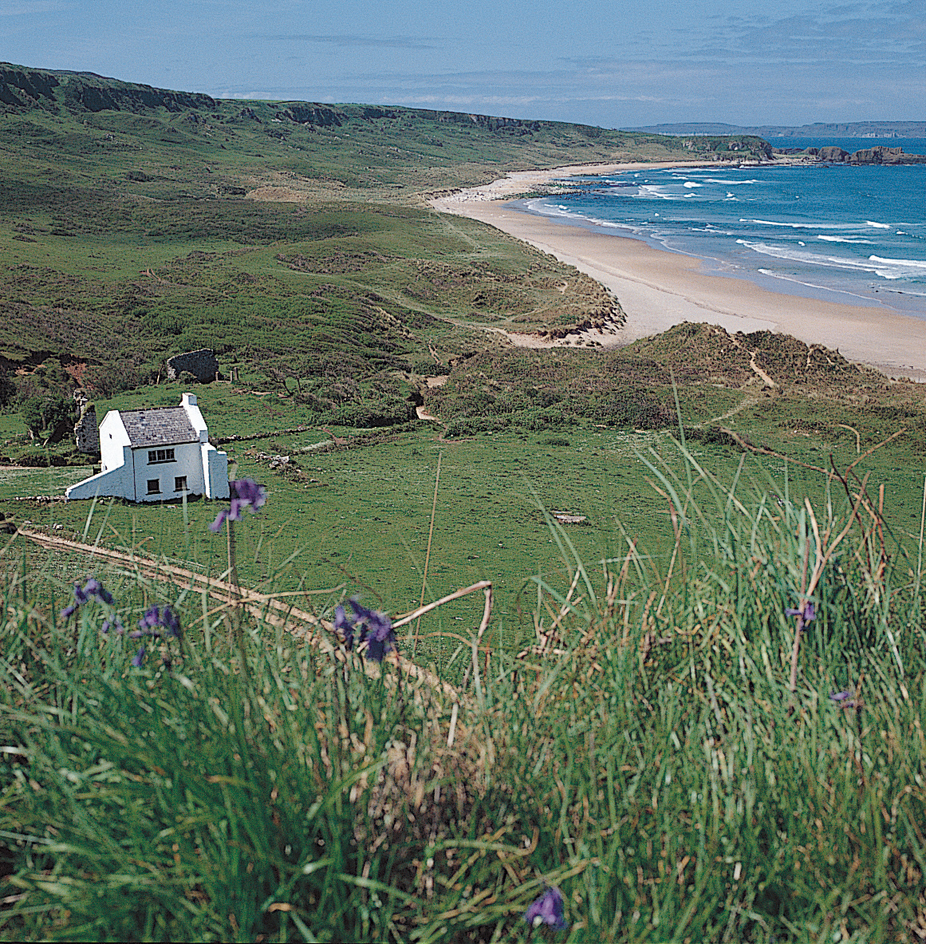
The highest peak in Northern Ireland is Slieve Donard << sleev DON uhrd >>. It rises 2,796 feet (852 meters) in the Mourne Mountains near the southeast coast. Other mountain ranges include the Sperrin Mountains in the northwest and the Mountains of Antrim in the northeast.
Lakes, rivers, and bays.
Northern Ireland has many smooth, clear lakes called loughs. Lough Neagh, near the center of the country, covers about 150 square miles (388 square kilometers). It is the largest lake in the United Kingdom and the largest body of water on the island of Ireland. See Lough Neagh.

The longest river in Northern Ireland is the River Bann. The Bann actually is two rivers. The Upper Bann, which is 47 1/2 miles (76.4 kilometers) long, begins in the Mourne Mountains and flows northwestward into the southern end of Lough Neagh. The Lower Bann begins at the northern end of the lake and flows north 38 miles (61 kilometers) into the Atlantic Ocean. Many small, winding rivers empty into the Bann. See Bann.
Several large bays, which are also called loughs, cut into the coast. Lough Foyle and Belfast Lough provide excellent harbors for Londonderry and Belfast.
Economy
Service industries
are the leading employers in Northern Ireland. Major service industries include education, e-commerce (industries based on the Internet), government services, health care, telecommunications, and tourism.
Manufacturing.
Traditional industries, such as linen manufacturing and shipbuilding, declined in importance during the later 1900’s. Most manufacturing now involves engineering, information and communications, aerospace, and pharmaceuticals (medicinal drugs). Engineering manufacturing includes the making of car parts and the assembly of fork-lift trucks and buses. Telecommunications equipment, computer software, and electronics are important information and communications industries. The manufacturing of components for the aerospace industry is a major employer. Several of Northern Ireland’s most valuable companies make pharmaceuticals. Other important manufactured goods include processed foods and rubber and plastic products.
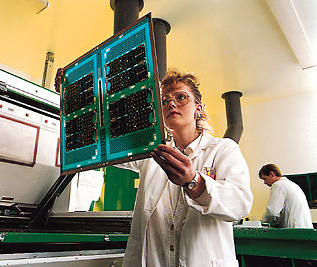
Beautiful pottery and hand-cut crystal are also made in Northern Ireland. The village of Belleek in County Fermanagh is famous for its delicate china.
Agriculture and fishing.
Cattle, chickens, eggs, hogs, milk, potatoes, and sheep are among Northern Ireland’s most important agricultural products. Food processing, particularly for major United Kingdom and European supermarket chains, is a major industry. Farmers grow much barley and hay for animal feed. Other agricultural products include butter, cheese, and mushrooms. Orchards in the district of Armagh produce apples, pears, and plums. 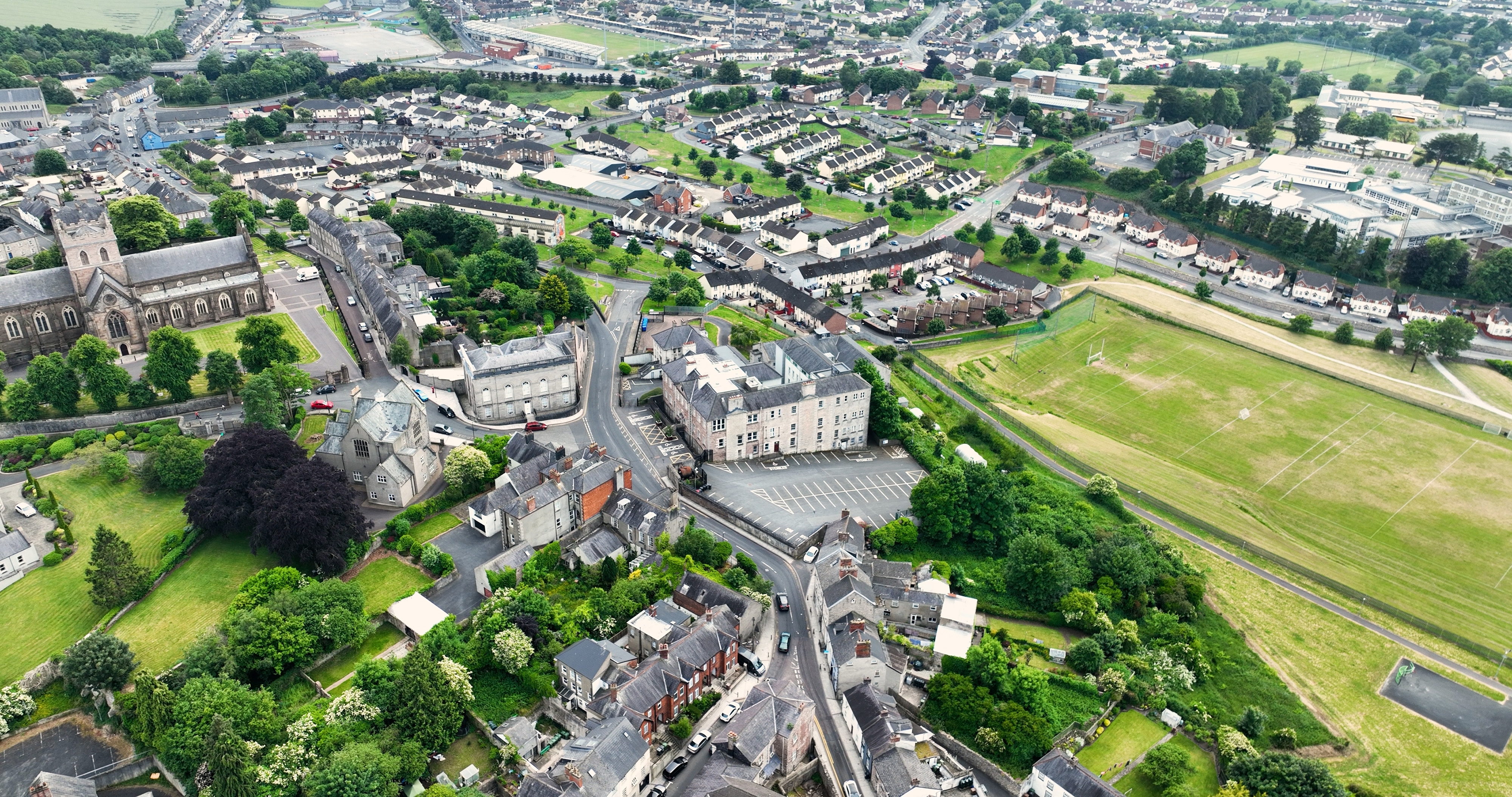
The fishing fleet of Northern Ireland processes cod, herring, lobsters, mackerel, and scallops, mainly from the Irish Sea. Catches are declining because of overfishing, however. Salmon and trout are netted in the rivers Foyle and Bann, and eels are caught in Lough Neagh and Lough Erne.
Transportation and communication.
A road system crisscrosses Northern Ireland. Bus service links Belfast and Londonderry to most other major towns and to points in the Republic of Ireland. A state-owned railroad system links Belfast and Londonderry with each other; with Newry, Larne, and Bangor in Northern Ireland; and with Dublin in the Irish Republic. Large amounts of freight pass through the seaports of Belfast, Coleraine, Larne, Londonderry, and Warrenpoint. Regular passenger ferry service connects Belfast and Larne with ports in western Scotland. Northern Ireland has three airports handling passenger flights: Belfast International, Belfast City, and City of Derry. 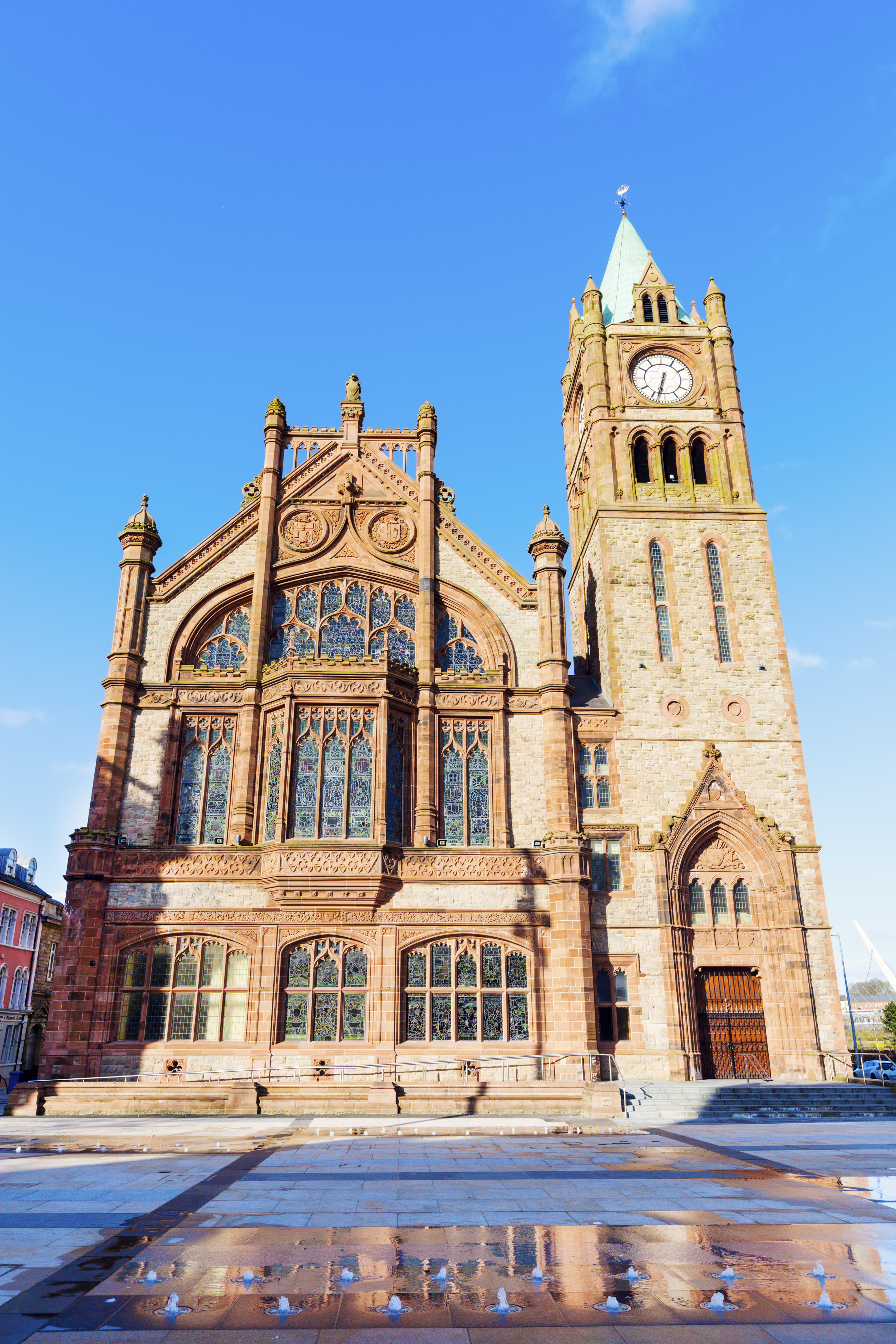
Northern Ireland has several daily newspapers. The leading papers are the Belfast Telegraph, The Irish News, and the News Letter, all three published in Belfast. Two British Broadcasting Corporation television channels and some independent channels serve Northern Ireland.
History
This section deals mainly with the history of Northern Ireland from the Protestant settlement in the 1600’s to recent developments. For information on the early history of the island of Ireland, see Ireland, History of.
Protestant settlement.
In 1541, King Henry VIII of England became king of Ireland. The Reformation, during which Henry changed England from a Roman Catholic to a Protestant nation, had little effect on Ireland. English rule there was ineffective, and most Irish people remained Catholics.
In 1607, local Irish chieftains who opposed the English fled from Ulster, a large province in northern Ireland. King James I of England then gave the chieftains’ land to English and Scottish Protestants. This action was partly responsible for the Protestant majority found in Northern Ireland today.
In the 1600’s, two attempts were made to reestablish Catholic power in Ireland. The first was an uprising that began in 1641 and was not put down by English forces until 1653.
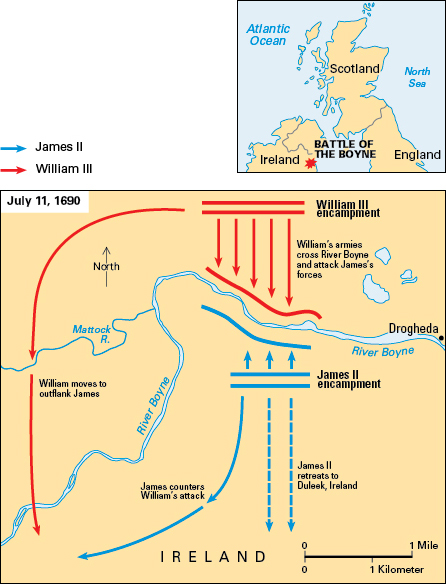
The second attempt was made under James II, a Catholic who became king of England in 1685. Many English people were unhappy with James’s policies and feared that a Catholic succession to the throne would be established. In 1688, the English invited William of Orange, a Protestant, to invade England with Dutch forces. James fled, and William of Orange was crowned as King William III in 1689. Meanwhile, James went to France and then to Ireland, where he organized an army to fight William. But James was defeated by William in the Battle of the Boyne in 1690. After the battle, Anglican Protestants owned most of the land in Ireland, controlled Ireland’s Parliament, and restricted the rights of Catholics and Presbyterian Protestants alike.
Union with Britain.
In 1801, the Act of Union took effect. This act abolished the Irish Parliament and created the United Kingdom of Great Britain and Ireland. During the 1800’s, the standard of living in northern Ireland rose as manufacturing flourished. But southern Ireland, where most of the Catholics lived, had a low living standard due to unequal distribution of land and a growing population.
In 1886, the British Liberal Party proposed a plan for Ireland called home rule. Under this plan, Ireland would have remained part of the United Kingdom, but it would have had its own parliament for domestic affairs. Ulster Protestants, who feared that such a parliament would be Catholic, opposed the plan. The plan was defeated in the British Parliament.
The division of Ireland.
By the early 1900’s, most Irish Catholics favored complete independence from the United Kingdom. But most of the Protestants in Ulster opposed independence because they did not want to be a minority in a Catholic country. In 1919, 73 Irish members of the British Parliament met in Dublin and declared all Ireland an independent state. Guerrilla warfare then broke out between the Irish rebels and British forces.
In 1920, the British Parliament passed the Government of Ireland Act. This act divided Ireland into two separate political units and gave each some powers of self-government. Ulster Protestants accepted the act, and the state of Northern Ireland was formed from six counties in Ulster. But southern Catholics rejected the act and demanded complete independence for a single, united Irish republic. In 1921, southern leaders and the United Kingdom signed a treaty that created the Irish Free State from 23 southern counties and 3 counties of Ulster. In 1937, the Irish Free State adopted a new constitution and changed its name to Eire (in Gaelic) or Ireland (in English). In 1949, Ireland cut all ties with the United Kingdom and became an independent republic.
Under the 1920 Government of Ireland Act, Northern Ireland was given its own governor, parliament, prime minister, and cabinet. The governor served as the official head of state, but the prime minister and cabinet held most of the power. Northern Ireland’s two-house Parliament handled such matters as administering the educational system and regulating commerce and agriculture. Certain other powers, such as levying income taxes and maintaining armed forces, were reserved for the British Parliament. Throughout Northern Ireland’s period of self-rule, the Unionist Party—which favored continued union with the United Kingdom—controlled the government.
Problems of division.
Many Roman Catholics in Northern Ireland refused to accept the 1920 partition (division) of Ireland, with some using armed violence in attempts to disrupt or end British rule in Northern Ireland. At the same time, many Protestants viewed the Roman Catholic minority in Northern Ireland with distrust or hostility. Conflict between the Protestant and Roman Catholic communities in Northern Ireland occurred frequently from the 1920’s through the 1960’s. The Northern Ireland government, dominated by the unionist Protestants, made little effort to win the loyalty of the Roman Catholics. For example, in some areas of Northern Ireland in which Roman Catholics formed a majority, election districts were set up to ensure that unionist minorities won control of local councils.
The division of Ireland was also opposed by the Irish Free State and, later, by the Republic of Ireland. Beginning in 1921, armed groups crossed into Northern Ireland and attacked British government installations. The raiders hoped to force the British to give up control of Northern Ireland.
The Troubles.
Catholics in Northern Ireland had long claimed that Protestants violated their civil rights and discriminated against them in jobs, housing, and other areas. In the late 1960’s, the struggle for civil rights turned violent, and a period known as the Troubles began. When the government tried to stop a civil rights demonstration in Londonderry in 1968, riots broke out. Serious riots occurred again in 1969 in Belfast and Londonderry. Troops were sent to Northern Ireland to restore order but failed to prevent further rioting. Meanwhile, the pro-Catholic Irish Republican Army (IRA) and other militant nationalist groups carried out bombings and other terrorist attacks. Loyalist paramilitary groups, such as the Ulster Defence Association and the Ulster Volunteer Force, also carried out attacks. 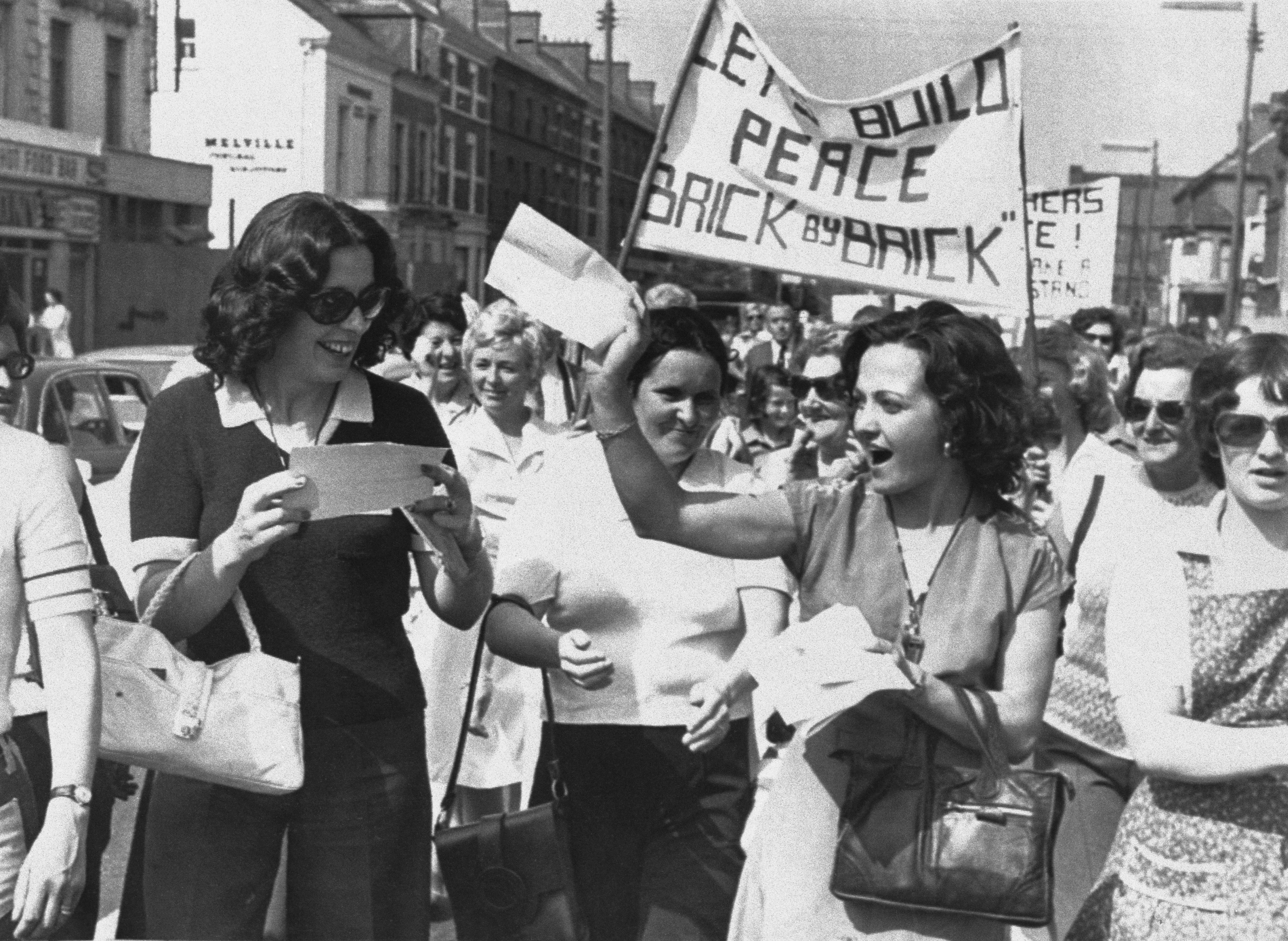
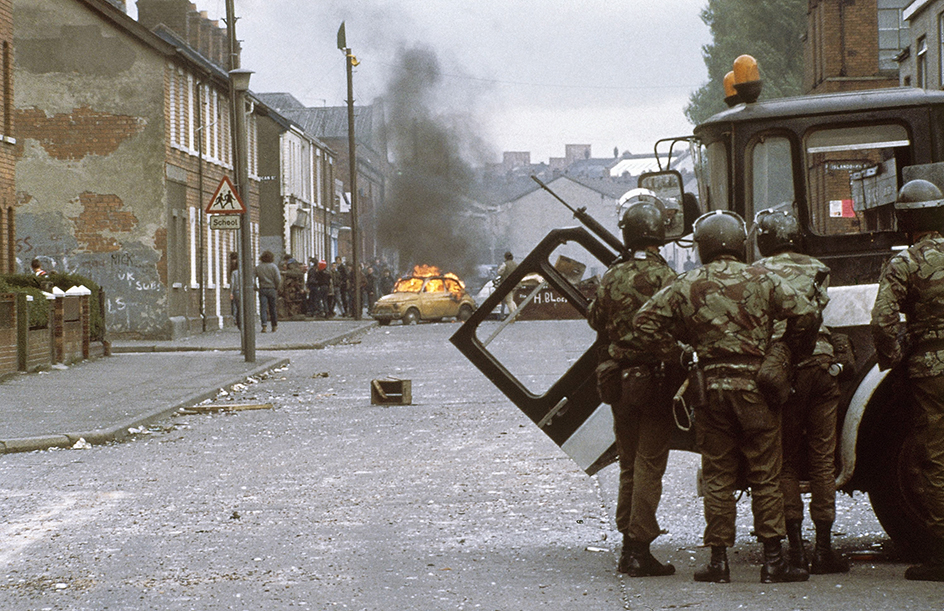
The continuing conflict led the British government to suspend Northern Ireland’s government in 1972 and to rule the region directly from London. But the Troubles continued. In 1973 and 1982, the United Kingdom set up assemblies in Northern Ireland that were designed to restore control over local affairs to the region. However, lack of cooperation between Protestants and Catholics led the British government to dissolve both assemblies.
In 1985, the United Kingdom and the Republic of Ireland signed the Anglo-Irish Agreement, which gave the government of the Irish Republic an advisory role in Northern Ireland’s affairs. Unionists and the IRA strongly opposed the agreement, and protests against the British government took place. See Anglo-Irish Agreement.
During the late 1980’s and early 1990’s, terrorist bombings by the IRA and related groups intensified in Northern Ireland and in England. The attacks also spread to continental Europe, where British military personnel and their families were the main targets. These actions led to violent responses by Protestant terrorist groups.
In December 1993, British Prime Minister John Major and Ireland’s Prime Minister Albert Reynolds held a meeting. The meeting resulted in the Anglo-Irish Joint Declaration on Northern Ireland. The declaration stated that a unified Ireland would not be forced and that Ireland would give up all claims to the north. It also said that the United Kingdom had neither economic nor territorial ambitions in the region and that Sinn Féin—the political wing of the IRA—could join peace negotiations if the party gave up violence.
In August 1994, the IRA announced a complete end to violence. Loyalist paramilitaries also gave up violence in October 1994. Sinn Féin President Gerry Adams began talks with Albert Reynolds in September of that year, and met with British government officials in December. However, the two sides reached a deadlock over demands that the IRA hand over its arms before being admitted to all-party talks. In 1996, the IRA ended its cease-fire. Later that year, Northern Ireland held elections to choose delegates to a special forum that would negotiate an end to the violence over Northern Ireland. In July 1997, the IRA declared a second cease-fire.
The Good Friday Agreement.
In 1997 and 1998, formal peace talks began that aimed to end the violence over Northern Ireland. The talks were the first negotiations to include all parties involved in the conflict.
In April 1998, the peace talks ended with an agreement, referred to as the Good Friday Agreement or the Belfast Agreement, that was then put to referendums in both Ireland and Northern Ireland. Voters approved the agreement, which included a commitment to use peaceful means to resolve political differences and the framework for a disarmament process by the IRA. The agreement called for the establishment of a Northern Ireland legislative assembly with control over many local matters. It also called for the establishment of a North-South Ministerial Council, which would include government representatives from Northern Ireland and Ireland, and for a British-Irish Council, which would include representatives from the Irish parliament and the various legislative assemblies of the United Kingdom.
The new governing bodies began meeting in December 1999. Early in 2000, the agreement was suspended when the Protestants threatened to withdraw from the government to protest against a lack of disarmament by the IRA. After months of negotiations, the IRA proposed a new disarmament plan, and the power-sharing government resumed. Disagreements over IRA disarmament caused two one-day suspensions of the Northern Ireland government in 2001, but the disputes were resolved after international monitors confirmed that the IRA had begun to disarm. Despite the peace agreement, civil unrest between Catholics and Protestants continued to plague Northern Ireland. In October 2002, the British government again suspended the assembly and resumed direct rule of Northern Ireland from London.
In 2005, the IRA announced that it would stop using violence and destroy its weapons. In response, the United Kingdom began reducing the number of troops it had stationed in Northern Ireland. Under the terms of the Good Friday Agreement, the last of the checkpoints between Northern Ireland and the Republic of Ireland were removed.
In May 2006, the Northern Ireland Assembly met for the first time since it had been suspended in 2002. British and Irish officials began working to establish a power-sharing government in Northern Ireland. In January 2007, Sinn Féin members voted to cooperate with the Police Service of Northern Ireland. This decision by Sinn Féin, the Irish nationalist political party allied with the IRA, paved the way for restoring a British-Irish coalition government in the Northern Ireland Assembly.
In the March 2007 parliamentary elections, the Democratic Unionist Party (DUP) won the most seats in the Assembly, and Sinn Féin finished second. The DUP and other unionist parties have sought to maintain Northern Ireland’s union with the United Kingdom. Sinn Féin has sought to unite Northern Ireland with the Republic of Ireland. DUP leader Ian Paisley and Sinn Féin leader Gerry Adams met for the first time on March 26, 2007, and agreed to work together in Northern Ireland’s power-sharing government, which began in May 2007.
The British Army ended its 38-year military campaign, which had become known as Operation Banner, in Northern Ireland at the end of July 2007. It was the British Army’s longest continuous military operation. British troops had been sent to Northern Ireland in 1969 to support Northern Ireland’s police force after clashes broke out between the mostly Protestant British unionists and the mostly Catholic Irish nationalists. British soldiers remained in the region to help combat the violence between both sides. Since 2005, British unionists and Irish nationalists have worked toward peaceful solutions to their differences, including the establishment of the power-sharing coalition in the Northern Ireland Assembly.
The passage of the Brexit referendum in 2016 influenced developments in Northern Ireland. As a result of the referendum, the United Kingdom officially left the European Union (EU) in 2020, putting Northern Ireland in a separate customs union from its neighbor, the Republic of Ireland. The Northern Ireland Protocol, an agreement regulating EU and U.K. trade involving the region, went into effect in 2021. The agreement introduced a regulatory “sea border,” in which British goods faced inspection at Northern Ireland ports. The DUP and other unionist parties strongly opposed the sea border imposed by the protocol because it made Northern Ireland subject to EU trade laws. Many unionists believed that the protocol gave Northern Ireland a diminished political and economic status compared with other divisions of the United Kingdom.
Uncertainty regarding Northern Ireland’s post-Brexit economy contributed to political changes. In February 2022, DUP leader Paul Givan resigned as first minister in protest of the Northern Ireland Protocol. In May elections, Sinn Féin for the first time won the most seats in the Northern Ireland Assembly. The DUP, however, used its status as the largest unionist party to block attempts to elect an Assembly speaker or choose new leaders in the power-sharing government.
In February 2023, U.K. Prime Minister Rishi Sunak announced that U.K. and EU negotiators had reached an agreement resolving many Northern Ireland trade issues. The deal, known as the Windsor Framework, promised to establish two trade systems at Northern Ireland ports. United Kingdom goods destined to remain in Northern Ireland would pass through a “green lane” requiring minimal paperwork and customs checks. Goods due to travel to the Republic of Ireland would enter a “red lane” involving more robust customs checks. The two-lane trade deal did not satisfy most unionists, however, and the DUP continued its boycott of the Northern Ireland government.
In February 2024, the British Parliament approved measures removing most of the remaining customs inspections on goods shipped to Northern Ireland from other parts of the United Kingdom. As a result, the DUP dropped its boycott of the Northern Ireland Assembly and joined a power-sharing government with Sinn Féin. Sinn Féin deputy leader Michelle O’Neill became the first nationalist first minister in Northern Ireland’s history.
